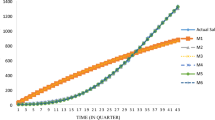Abstract
This paper presents a stochastic model of the adoption process for durables that explicitly incorporates heterogeneity in adoption rates among the consumers. The model assumes that the individual adoption times follow the Weibull distribution. Heterogeneity in adoption rates is represented by the gamma distribution. The resulting Burr distribution is more general than the Bass model, fits data as well as the Bass model estimated using OLS regression, and has parameters that can be used to make inferences about individual adoption behavior without being influenced by spurious aggregation effects.
Similar content being viewed by others
References
Bass, Frank M. (1969). “A New Product Growth Model for Consumer Durables,”Management Science 15 (January): 215–227.
Chatterjee, Rabikar, and Jehoshua Eliashberg (1990). “Innovative Diffusion Process: A Micro-Modeling Approach,”Management Science 36 (September), 1057–1079.
Dubey, Satya D. (1968). “A Compound Weibull Distribution,”Naval Research Logistics Quarterly 15, 179–188.
Easingwood, Christopher J., Vijay Mahajan, and Eitan Muller. (1983). “A Nonuniform Influence Innovation Diffusion Model of New Product Acceptance,”Marketing Science 2 (Summer): 273–296.
Lattin, James M., and John H. Roberts. (1989). “Modeling the Role of Risk-Adjusted Utility in the Diffusion of Innovations,” Working Paper 1019, Graduate School of Business, Stanford University.
Mahajan, Vijay, Charlotte H. Mason, and V. Srinivasan. (1986). “An Evaluation of Estimation Procedures for New Product Diffusion Models.” In Vijay Mahajan and Yoram Wind, (eds.),Innovation Diffusion Models of New Product Acceptance, Cambridge, MA: Ballinger Publishing Company.
Mahajan, Vijay, Eitan Muller, and Frank M. Bass. (1990). “New Product Diffusion Models in Marketing: A Review and Directions for Research,”Journal of Marketing 54 (January): 1–26.
Mahajan, Vijay, and Robert A. Peterson. (1985).Models for Innovative Diffusion. Beverly Hills, CA: Sage Publications Inc.
Mahajan, Vijay, and Yoram Wind. (1986).Innovation Diffusion Models of New Product Acceptance. Cambridge, MA: Ballinger Publishing Company.
Meyer, Paul L. (1970).Introductory Probability and Statistical Applications, 2nd ed. Reading, MA: Addison-Wesley.
Morrison, Donald G., and David C. Schmittlein. (1980). “Jobs, Strikes and Wars: Probability Models for Duration,”Organizational Behavior and Human Performance 25, 224–251.
Oren, Shmuel S., and Rick G. Schwartz. (1988). “Diffusion of New Products in Risk-Sensitive Markets,”Journal of Forecasting 7 (October–December): 273–287.
Schmittlein, David C., and Vijay Mahajan. (1982). “Maximum Likelihood Estimation for an Innovation Diffusion Model of New Product Acceptance,”Marketing Science 1 (Winter): 57–78.
Schmittlein, David C., and Donald G. Morrison. (1983). “Modeling and Estimation Using Job Duration Data,”Organizational Behavior and Human Performance 32: 1–22.
Srinivasan, V., and Charlotte H. Mason. (1986). “Nonlinear Least Squares Estimation of New Product Diffusion Models,”Marketing Science 5 (Spring): 169–178.
Sultan, Fareena, John U. Farley, and Donald R. Lehmann. (1990). “A Meta-Analysis of Diffusion Models,”Journal of Marketing Research 22 (February): 70–77.
Vaupel, James W., and Anatoli I. Yashing. (1985). “Heterogeneity's Ruses: Some Surprising Effects of Selection on Population Dynamics,”The American Statistician 39 (August): 3.
Author information
Authors and Affiliations
Additional information
Special thanks are due to Professor Donald Lehmann for providing numerous suggestions and encouragement at all stages of the study. Thanks are also due to Professors David Schmittlein and Richard Colombo and two anonymous reviewers for helpful comments on an earlier draft of the paper.
Rights and permissions
About this article
Cite this article
Narayanan, S. Incorporating heterogeneous adoption rates in new product diffusion: A model and empirical investigations. Marketing Letters 3, 395–406 (1992). https://doi.org/10.1007/BF00993923
Issue Date:
DOI: https://doi.org/10.1007/BF00993923




